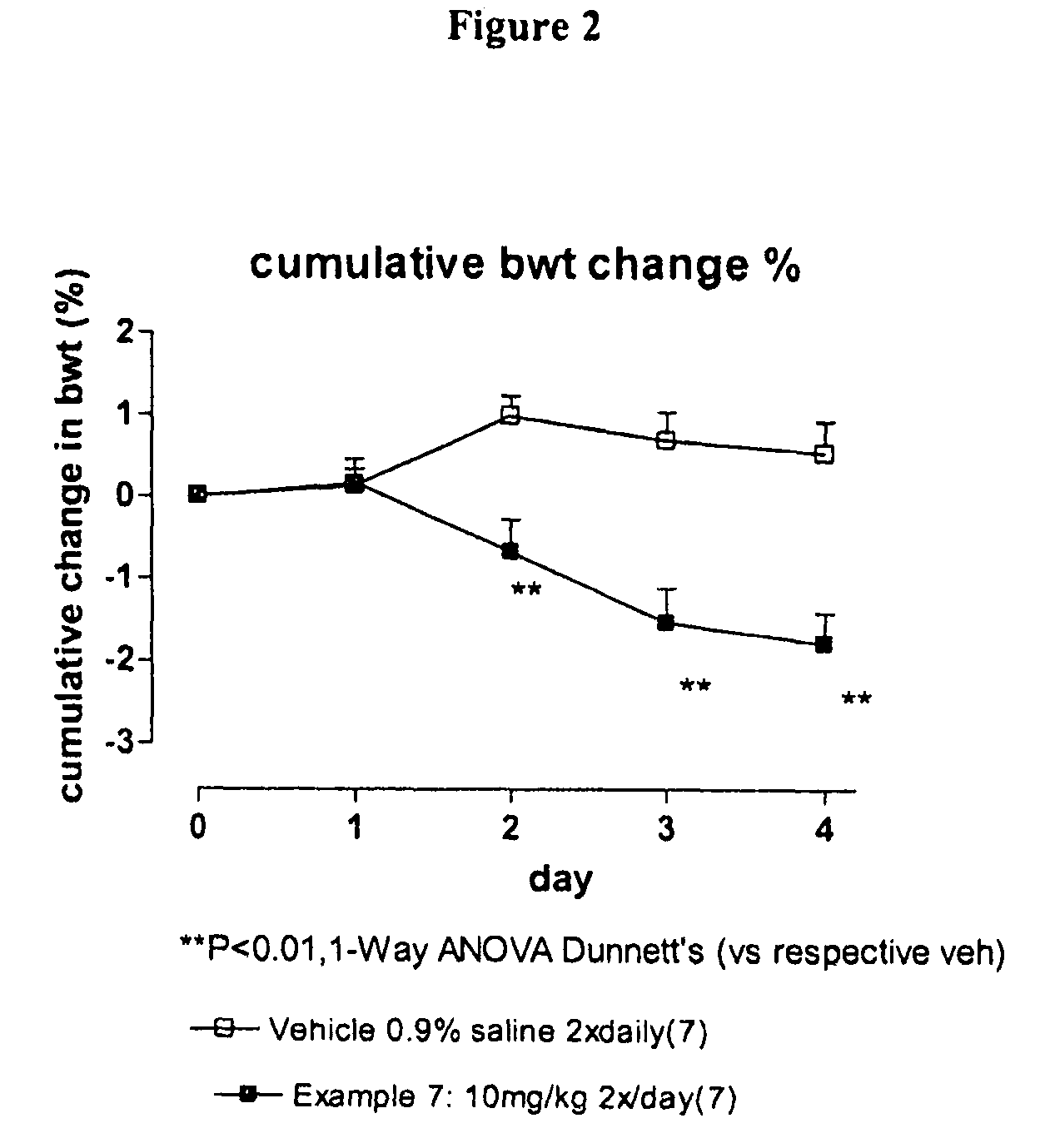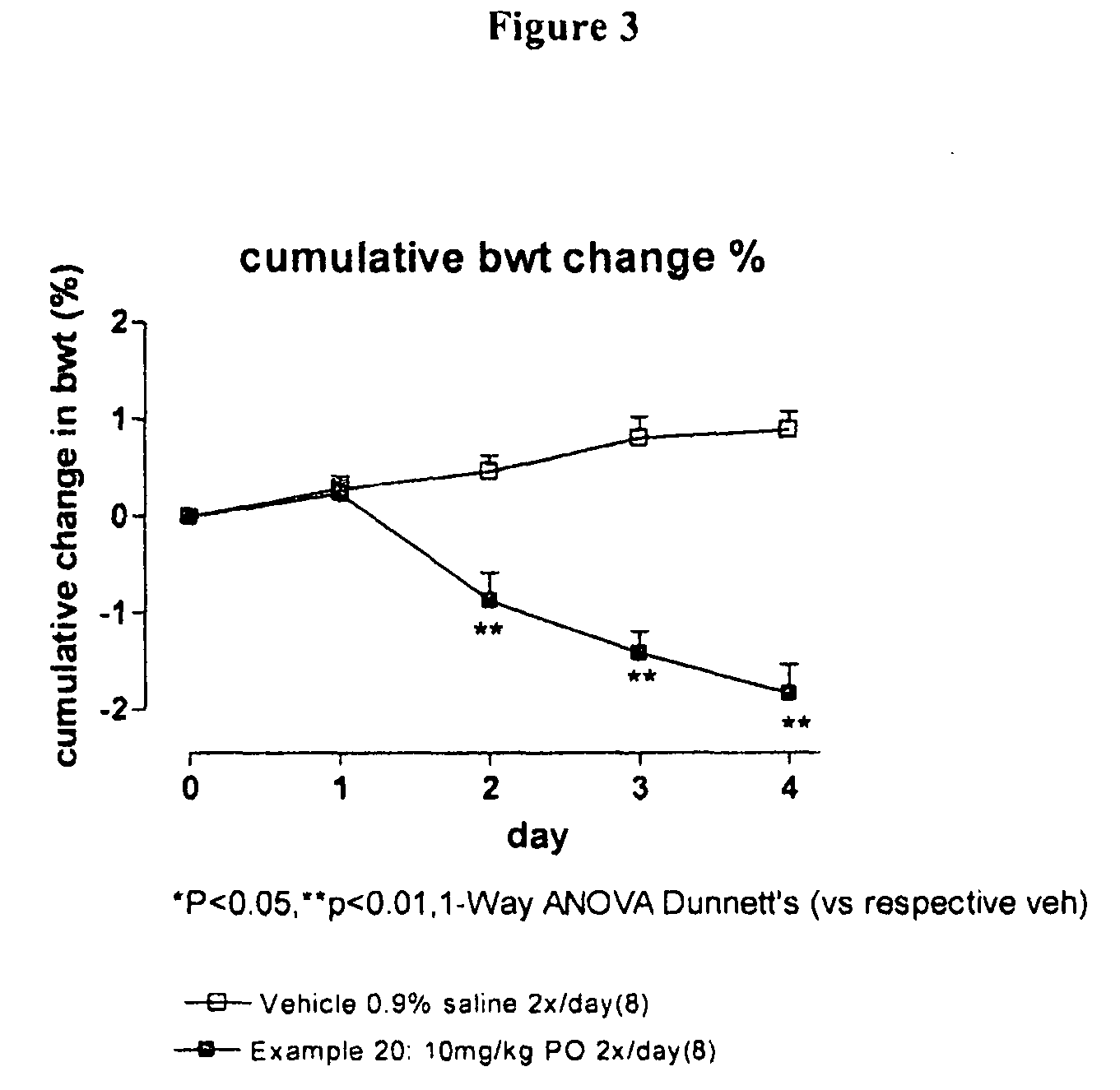Compounds I
a piperazine and derivative technology, applied in the field of compounds i, can solve the problem of deficiency in the obese state of leptin transport into the brain, and achieve the effect of reducing body weight and food intak
- Summary
- Abstract
- Description
- Claims
- Application Information
AI Technical Summary
Benefits of technology
Problems solved by technology
Method used
Image
Examples
example 1
[(3R)-1-Methylpiperidin-3-yl]methyl 4-(4-methylphenyl)piperazine-1-carboxylate
[0232]
[0233]A 2M solution of LiAlH4 in THF (14.0 mL, 28.0 mmol) was added drop-wise to a solution of (R)-tert-butyl 3-(hydroxymethyl)piperidine-1-carboxylate (5.00 g, 23.2 mmol) in THF (30 mL) under argon at 0° C. The reaction mixture was allowed to warm to room temperature over 2 hours and stirred at room temperature for 17 hours. The reaction mixture was cooled to 0° C. and a 1M aq NaOH solution (4.0 mL) was added drop-wise. Water (2 mL) was added and the resulting mixture stirred at room temperature for 2 hours. The white solid was removed by filtration. The filtrate was concentrated in vacuo to give (R)-(1-methylpiperidin-3-yl)methanol (3.19 g, 106%) as a colourless oil which was used without further purification.
[0234]Analytical LCMS: purity ˜90% (System C, RT=0.46 min), ES+: 130.1 [MH]+.
[0235]Sodium hydride (0.70 g, 60% dispersion in mineral oil, 17.5 mmol) was suspended in heptane (10 mL) under an a...
example 2
[(3S)-1-Methylpiperidin-3-yl]methyl 4-(4-methylphenyl)piperazine-1-carboxylate
[0237]
[0238](S)-(1-Methylpiperidin-3-yl)methanol (1.50 g, 11.6 mmol; prepared according to Example 1 but starting from (S)-tert-butyl 3-(hydroxymethyl)piperidine-1-carboxylate) was dissolved in DCM (20 mL) and cooled to 0° C. NMM (1.30 mL, 12.2 mmol) and nitrophenyl chloroformate (2.46 g, 12.2 mmol) were added. The reaction mixture was stirred at 0° C. for 2 hours and then a solution of 4-(4-methylphenyl)piperazine dihydrochloride (1.88 g, 7.5 mmol) and DIPEA (3.70 mL, 22.1 mmol) in DMF (40 mL) was added. The reaction mixture was stirred at room temperature for 2 hours and then concentrated in vacuo. The residue was dissolved in EtOAc (300 mL) and then washed sequentially with 1M aq Na2CO3 solution (5×200 mL), dried (MgSO4) and concentrated in vacuo. The residue was purified by normal phase column chromatography (eluting with DCM, followed by a 85:15 mixture of DCM:MeOH) followed by reverse phase HPLC (Adv...
example 3
[(2S)-1,4-Dimethylpiperazin-2-yl]methyl 4-phenylpiperazine-1-carboxylate
[0240]
[0241]To a solution of 1,4-dimethyl-(S)-2-hydroxymethyl piperazine (Intermediate 3; 1.49 g, 10.3 mmol) in THF (20 mL) at 0° C. was added sodium hydride (1.24 g, 60% dispersion in mineral oil, 31.0 mmol). The reaction mixture was stirred for several minutes at 0° C. and then 4-nitrophenyl 4-phenylpiperazine-1-carboxylate (Intermediate 2; 3.72 g, 11.4 mmol) in THF (20 mL). The reaction mixture was allowed to warm to room temperature and stirred for 7 hours. The reaction mixture was then cooled to 0° C. and quenched with the drop-wise addition of sat aq NaHCO3 solution. The THF was removed in vacuo, the aqueous phase extracted with EtOAc (×3), combined organic phases washed with sat aq NaHCO3 solution (×6), dried (MgSO4) and concentrated in vacuo. The residue was suspended in water: formic acid solution [1:1] (20 mL), filtered and the filtrate was purified by reverse phase column chromatography (gradient elut...
PUM
 Login to View More
Login to View More Abstract
Description
Claims
Application Information
 Login to View More
Login to View More - R&D
- Intellectual Property
- Life Sciences
- Materials
- Tech Scout
- Unparalleled Data Quality
- Higher Quality Content
- 60% Fewer Hallucinations
Browse by: Latest US Patents, China's latest patents, Technical Efficacy Thesaurus, Application Domain, Technology Topic, Popular Technical Reports.
© 2025 PatSnap. All rights reserved.Legal|Privacy policy|Modern Slavery Act Transparency Statement|Sitemap|About US| Contact US: help@patsnap.com



